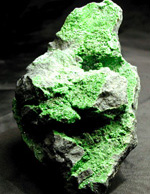
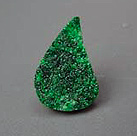

Few people, other than gem collectors, are familiar with Uvarovite garnets, and fewer still have seen a transparent faceted gem of this variety. The main reason is that although crystals of reasonable size do occur on occasion in chromite and serpentine deposits, they are generally opaque. Very rarely, a tiny portion of a crystal will have transparency and a small gem can be cut. This type of garnet, therefore, would usually not be included in lists of gem garnets if it weren't for one major source area in the Ural Mts. of Russia that yields lovely Uvarovite drusy. Uvarovite, one of the calcium rich members of the garnet group, is formed through metamorphism of certain silica rich limestones and is often found in association with chromite and serpentine. Those "parent" rocks contain chromium, the source of Uvarovite's rich and distinctive medium dark to dark emerald green color. Finland, South Africa and California provide secondary sources, but little of the material from those locales rivals the beauty of the Russian gems, although some of the Finnish deposits produce large individual or crystal clusters that are cherished by mineral collectors.



When minerals adopt a drusy crystal habit, tiny to very tiny crystals are deposited on a matrix surface. It is these rather rare occurrences that give rise to the lovely green gemstone, Uvarovite garnet drusy. This gem is unique on two counts --> no such vibrant green color is to be found in the world of undyed drusy materials, and, in addition it is the only species of garnet that is consistently green (idiochromatic). The somewhat intimidating name (pronounced: oo--vare--oh--vite) is in honor of Count S. S, Uvarov, a Russian nobleman once president of the St. Petersburg Academy.
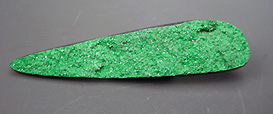
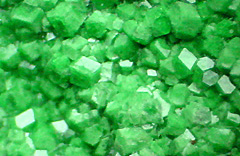
Although a member of the cubic crystal system, individual Uvarovite crystals can form more rounded shapes, with 12 - 24 rhomboid or trapezoidal faces, in rare cases achieving almost a perfect soccer-ball shape.
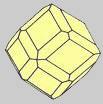
Since the rise in popularity of drusy gems with designers in the last decade, Uvarovite itself, and jewelry using it, have occasionally been featured in photos in gem and jewelry publications.
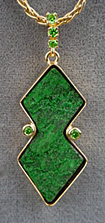
Garnets, in general, are durable gemstones which can be used for all jewelry purposes, but Uvarovite drusy, as with all drusy materials, should be considered more fragile than a faceted or cabbed gem of its species. Reasonable care is needed in setting and wearing to prevent crushing or dislodging the tiny crystals adhering to the matrix. Ultrasonics and steam cleaners would probably be too harsh, but the old standby of a soft brush, warm water and mild detergent would be fine. Use in pendants, brooches and earrings would be safe, but use in bracelets, belt buckles or rings would be ill advised unless the settings were extremely protective and the pieces infrequently worn.
Uvarovite is is too rarely used to have a "standard" price range. Nonetheless, certain guidelines can help the buyer in choosing a good piece of material and getting good value for their money. As with all drusy materials, highest value is accorded to pieces that show even coverage of the matrix by the crystals. With this particular gem whose refractive index is quite high, having crystals which are larger than the powdery form seen in most deposits creates an attractively sparkly surface and are preferred. Like most gems, the brighter the color and more attractive the cut, the higher the value. All else being equal, larger pieces sell for more per carat than the smaller ones as most useable roughs are small.
Toughness: Fair